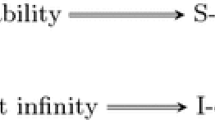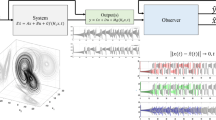Abstract
A new method is proposed to check the detectability for a class of rectangular linear time invariant descriptor systems. The method is based on the properties of restricted system equivalent, derived here from a given descriptor system by means of simple matrix theory. Equivalence between the detectability of a given descriptor system and that of a normal system is established. The proposed result is applied to design full- and reduced-order observers for the same class of descriptor systems. Some illustrative examples are provided.




Similar content being viewed by others
References
Campbell SL (1980) Singular systems of differential equations, vol 40. Pitman, London
Dai L (1989) Singular control systems, vol 118. Springer, Berlin
Duan GR (2010) Analysis and design of descriptor linear systems, vol 10. Springer, Berlin
Riaza R (2008) Differential-algebraic systems: analytical aspects and circuit applications. World Scientific, Singapore
Kumar A, Daoutidis P (1999) Control of nonlinear differential algebraic equation systems with applications to chemical processes, vol 397. CRC Press, Boca Raton
Small SJ (2011) Runge-Kutta type methods for differential-algebraic equations in mechanics. University of Iowa, Iowa
Darouach M, Boutayeb M (1995) Design of observers for descriptor systems. IEEE Trans Autom Control 40(7):1323–1327
Dai L (1989) The difference between regularity and irregularity in singular systems. Circuits Syst Signal Process 8(4):435–444
Feng J, Lam J, Xu S (2009) Finite-time functional observers for descriptor systems. Int J Control Autom Syst 7(3):341–347
Gupta MK, Tomar NK, Bhaumik S (2014) Detectability and observer design for linear descriptor system. In: 22nd Mediterranean conference on control and automation. IEEE, pp 1094–1098
Gupta MK, Tomar NK, Bhaumik S (2014) PD observer design for linear descriptor systems. In: International conference on mathematical sciences. Elsevier, pp 40–43
Lewis F (1990) Geometric design techniques for observers in singular systems. Automatica 26(2):411–415
Minamide N, Arii N, Uetake Y (1989) Design of observers for descriptor systems using a descriptor standard form. Int J Control 50(6):2141–2149
Ren J, Zhang Q (2010) PD observer design for descriptor system: an LMI approach. Int J Control Autom Syst 8(4):735–740
Shafai B, Carroll R (1986) Design of minimal-order observer for singular systems. In: American control conference. IEEE, pp 2077–2082
Uetake Y (1989) Pole assignment and observer design for continuous descriptor systems. Int J Control 50(1):89–96
Verhaegen M, Van Dooren P (1986) A reduced order observer for descriptor systems. Syst Control Lett 8(1):29–37
Wu AG, Duan GR (2006) Design of PI observers for continuous-time descriptor linear systems. IEEE Trans Syst Man Cybern Part B Cybern 36(6):1423–1431
Wu AG, Duan GR (2007) Design of PD observers in descriptor linear systems. Int J Control Autom Syst 5(1):93–98
Darouach M, Zasadzinski M, Hayar M (1996) Reduced-order observer design for descriptor systems with unknown inputs. IEEE Trans Autom Control 41(7):1068–1072
Hou M, Müller PC (1995) Design of a class of Luenberger observers for descriptor systems. IEEE Trans Autom Control 40(1):133–136
Koenig D, Mammar S (2002) Design of proportional-integral observer for unknown input descriptor systems. IEEE Trans Autom Control 47(12):2057–2062
Müller PC, Hou M (1991) On the observer design for descriptor systems. In: Decision and control. IEEE, pp 1960–1961
Müller PC, Hou M (1993) On the observer design for descriptor systems. IEEE Trans Autom Control 38(11):1666–1671
Gupta MK, Tomar NK, Bhaumik S (2014) On observability of irregular descriptor systems. In: Advances in control and optimization of dynamical systems, IFAC, vol 3, pp 376–379
Sinha A (2007) Linear systems. CRC Press, Boca Raton
Gahinet P, Nemirovskii A, Laub AJ, Chilali M (1994) The LMI control toolbox. IEEE Decis Control 2:2038–2038
Acknowledgments
The support provided by the University Grants Commission through senior research fellowship to the first author is gratefully acknowledged. We are really grateful to the reviewers for providing systematic and motivating comments on the previous versions of the paper. These comments were very helpful for the improvement of the paper.
Author information
Authors and Affiliations
Corresponding author
Additional information
This work was supported by CSIR, New Delhi (Grant No. 25(0195)11/EMR-II).
Appendix: Algorithm to find matrix \(R\)
Appendix: Algorithm to find matrix \(R\)
- 1.:
-
Determine
$$\begin{aligned}&p_1:= \hbox {rank of matrix } C\\&n_0 \times n:= \hbox {order of matrix } E. \end{aligned}$$ - 2.:
-
Check \(\hbox {rank}\begin{bmatrix} E \\ C \\ \end{bmatrix}=n\), then go to steps 3–8.
- 3.:
-
Carry out the singular value decomposition (SVD) of matrix \(C=U_1\begin{bmatrix} D_1&\quad 0 \\ 0&\quad 0 \\ \end{bmatrix} V_1^T\).
- 4.:
-
Calculate \(P=V_1\begin{bmatrix} D_1^{-1}&\quad 0 \\ 0&\quad I_{n-p_1} \\ \end{bmatrix}\).
- 5.:
-
Calculate \(E_{2}=EP\begin{bmatrix} 0_{p_1 \times (n-p_1)} \\ I_{n-p_1} \\ \end{bmatrix}\).
- 6.:
-
Carry out the SVD of matrix \(E_{2}=U_2\begin{bmatrix} D_2 \\ 0 \\ \end{bmatrix}V_2^T\).
- 7.:
-
Calculate \(R_0=\begin{bmatrix} 0&\quad I_{n_0+p_1-n} \\ V_2D_2^{-1}&\quad 0 \\ \end{bmatrix}U_2^T\).
- 8.:
-
Calculate \(R=P\begin{bmatrix} 0_{(n-n_0) \times n_0} \\ R_0\\ \end{bmatrix} \).
Rights and permissions
About this article
Cite this article
Gupta, M.K., Tomar, N.K. & Bhaumik, S. On detectability and observer design for rectangular linear descriptor systems. Int. J. Dynam. Control 4, 438–446 (2016). https://doi.org/10.1007/s40435-014-0146-x
Received:
Revised:
Accepted:
Published:
Issue Date:
DOI: https://doi.org/10.1007/s40435-014-0146-x




